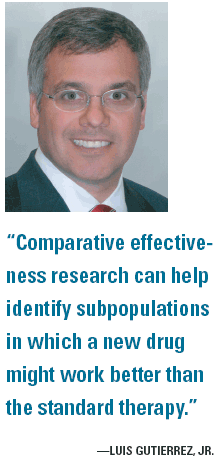Push for comparative effectiveness research
As comparative effectiveness research matures from a political buzz phrase to a decision-making process, leaders in the oncology community are concerned about the effect this latest government initiative might have on community practices that already feel overregulated.
ABSTRACT: Cancer investigators already practice comparative effectiveness research in studies that examine different drug combinations and doses, according to an industry insider.
As comparative effectiveness research matures from a political buzz phrase to a decision-making process, leaders in the oncology community are concerned about the effect this latest government initiative might have on community practices that already feel overregulated.

The economic stimulus package provides $1.1 billion for CER, which determines the treatments or procedures that work best for a particular disease or group of patients. Such analyses may focus only on the medical benefits and risks of various options or may also consider the costs. In addition to clinical trials, CER may include retrospective approaches such as meta-analyses or retrospective studies using medical claims data.
The U.S. Department of Health and Human Services recently appointed 15 members to a Federal council that will help coordinate the CER funding. According to the department, “the council will not recommend clinical guidelines for payment, coverage, or treatment.”
NIH has released its priorities for comparative effectiveness projects, including research in cancer prevention, screening, and treatment; the cost-effectiveness of patient navigation; and use of CISNET models to evaluate competing diagnostic technologies and treatments.
Oncology News International spoke with Luis T. Gutierrez, Jr., about CER and its possible impact on oncology. Mr. Gutierrez is president of periapproval and market access services at Covance, a contract research organization that helps pharmaceutical and biotech companies quantify the clinical and economic value of their products.
Q: In the context of the current political debate over healthcare reform, what does the term comparative effectiveness research mean?
Mr. Gutierrez: The goal of CER is to determine which of two or more active therapies works best in real-world use. Much of the research that regulatory agencies require to bring a drug to market compares an agent against a placebo, whereas in CER you’re measuring against another active therapy that is already in use in a mainline therapy setting. Ideally, a new agent is measured against the current or historical standard.
It is important to note the difference between efficacy and effectiveness. Efficacy is the determination of how well a drug works in the patients for whom it is indicated in the way in which it is indicated, whereas effectiveness is the determination of how well a drug works in whomever takes it.
Thus, it gives more of a real-world element in which the patient population is not as clearly defined or screened as in a typical phase III trial.
Q: Can CER gather enough traction to move from concept to policy?
Mr. Gutierrez: Comparative effectiveness research already has traction in oncology where it is commonly used to study multiple drugs in different combinations and different dosing regimens after they are already available on the open market. We recently did an analysis of all the clinical trials that are posted on www.clinicaltrials.gov, and found that a sizeable proportion of cancer clinical trials are testing various regimens against each other.
Q: What effect can CER have on the drug development process?
Mr. Gutierrez: Comparative effectiveness can help identify subpopulations in which a new drug might work better than the standard therapy. If used this way, comparative effectiveness could stimulate the pipeline. Oncology products are now all about targeting the right tumor, the right patient, and the right tumor subtype.
The downside of comparative effectiveness would be to simply evaluate drugs for reimbursement based solely on cost per quality-adjusted life-year saved. It’s an approach similar to the policy in the United Kingdom in which the restrictions on reimbursement of high-cost drugs have a downward pressure on the drug pipeline.
Q: What’s your sense about pharma’s take on the CER initiative?
Mr. Gutierrez: The major pharma associations tried very hard to have language inserted in the stimulus package that would keep the focus on comparative clinical effectiveness research. I think pharma will embrace, or at least warm up to, the concept of comparative effectiveness as long as the goal is improved clinical outcomes and quality of care rather than a pure focus on costs.
Q: Any closing thoughts?
Mr. Gutierrez: If comparative effectiveness becomes the benchmark, companies might focus more on agents that relieve the burden of illness, and that may benefit diseases such as cancer that are very burdensome. But it comes down to what metrics and thresholds we set, because if you use a rigid cost per quality-adjusted life-year saved to identify the most effective treatment, then a disease like cancer doesn’t fair all that well.
A lot of comparative effectiveness may not pan out. Public dialogue will determine how it plays out and what society values in healthcare; research dollars and industry will follow that path.
Gedatolisib Combo With/Without Palbociclib May Be New SOC in PIK3CA Wild-Type Breast Cancer
December 21st 2025“VIKTORIA-1 is the first study to demonstrate a statistically significant and clinically meaningful improvement in PFS with PAM inhibition in patients with PIK3CA wild-type disease, all of whom received prior CDK4/6 inhibition,” said Barbara Pistilli, MD.